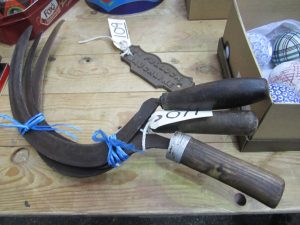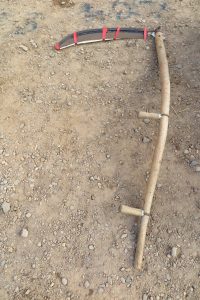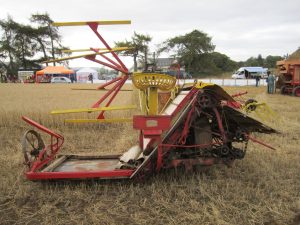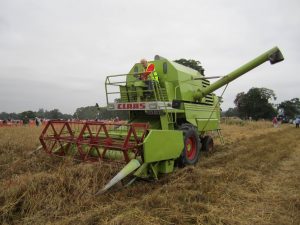The harvest is in full swing. So what was it like in bygone days?
The county reports of the Board of Agriculture and Internal Improvement, published between 1793 and 1817 include a great deal of information on agriculture and agricultural practices. The report for the county of Stirlingshire includes a wide-ranging report on harvesting of wheat. So what does the report say about it?
 “In reaping, the sickle is universally made use of. An evident improvement of the sickle is now very generally introduced. The old sickle, which is still most frequently used, is teethed somewhat like a saw; the teeth soon wear out, and, for the most part, the sickle is henceforth useless, unless the teeth be renewed on the anvil. The improved sickle is broader on the blade; it has no teeth, and is of a better metal; on the principle of the scythe, it is sharpened from time to time by a stone. It cuts with more ease than the other, and lasts for a much longer time.
“In reaping, the sickle is universally made use of. An evident improvement of the sickle is now very generally introduced. The old sickle, which is still most frequently used, is teethed somewhat like a saw; the teeth soon wear out, and, for the most part, the sickle is henceforth useless, unless the teeth be renewed on the anvil. The improved sickle is broader on the blade; it has no teeth, and is of a better metal; on the principle of the scythe, it is sharpened from time to time by a stone. It cuts with more ease than the other, and lasts for a much longer time.
 By the sickle the grain is, no doubt, cut down more regularly, and is more easily collected into sheaves than by any other method, but the operation is slow, and it requires many hands. it would be perhaps the most important acquisition to agricultural operations that has been made for a long while, if an instrument were invented, by which corns could be cut down, and the sametime gathered into sheaves, as hay is cut down by the scythe. In grounds completely level and free from stones , like the Cras of Stirlingshire, an estimate might at least be made in the proportional expense, whether by labour or by loss, or reaping corns with the sickle or with the scythe.
By the sickle the grain is, no doubt, cut down more regularly, and is more easily collected into sheaves than by any other method, but the operation is slow, and it requires many hands. it would be perhaps the most important acquisition to agricultural operations that has been made for a long while, if an instrument were invented, by which corns could be cut down, and the sametime gathered into sheaves, as hay is cut down by the scythe. In grounds completely level and free from stones , like the Cras of Stirlingshire, an estimate might at least be made in the proportional expense, whether by labour or by loss, or reaping corns with the sickle or with the scythe.
The size of the sheaves is proportioned to the length of the straw. In wet seasons they are not made large. Twelve of these in oats and barley, and fourteen in wheat make a shock, or, as we call it, a shook.  In placing the stock, attention is paid in this climate, as ought perhaps to be done in every other, throughout the kingdom, to the point of the compass from which the storm or weather most generally blows. If the side of the stock be placed towards the point, the greatest possibe surface is exposed to the weather, and the corn suffers accordingly; the end of the stock therefore is presented to the weather. In this district, from the circumstances of the weather, the stock is generally placed in a direction from S.W. to N.E. In narrow allies, and where hills and woods interfere, there may arise a difference of the currents of air, and in such situations experience must guide.
In placing the stock, attention is paid in this climate, as ought perhaps to be done in every other, throughout the kingdom, to the point of the compass from which the storm or weather most generally blows. If the side of the stock be placed towards the point, the greatest possibe surface is exposed to the weather, and the corn suffers accordingly; the end of the stock therefore is presented to the weather. In this district, from the circumstances of the weather, the stock is generally placed in a direction from S.W. to N.E. In narrow allies, and where hills and woods interfere, there may arise a difference of the currents of air, and in such situations experience must guide.
On account of the succulent nature of beans, pease, and other leguminous plants, they are left loose upon the ground for sometime before they are bound up into sheaves, that they may lose in part their superabundant juices.
In very wet and unfavourable seasons, a method is practised in this county, which perhaps is not much known elsewhere, and may be shortly stated. The sheaves, instead of being set up in stocks, are set up singly on the lower end, the band being slip up near the top, and the middle opened and exposed loosely to the current of the air. This method is here called gaiting. It is had recourse to only in extremity; there is much loss sustained by the exposure of the ears of corn to the weather and to the birds; but if there be only a few hours of drought and sunshine, the victual will not be finally lost.
 When the sheaves are exhausted of the moisture which had remained in the stalks, or which they had imbibed from the weather, they are built up into large ricks or stacks, of a circular form, and with conical form, and with conical tops, the eaves, at the commencement of the top, projecting over the body of the stack to ward off the rain. The conical top is thatched with straw. These stacks contain from 30 to 90 or 100 thrives of victual, a thrave being two stocks. No great quantity of grain is put ito the barn at once; it is safer in the stack from the depredations of vermin.
When the sheaves are exhausted of the moisture which had remained in the stalks, or which they had imbibed from the weather, they are built up into large ricks or stacks, of a circular form, and with conical form, and with conical tops, the eaves, at the commencement of the top, projecting over the body of the stack to ward off the rain. The conical top is thatched with straw. These stacks contain from 30 to 90 or 100 thrives of victual, a thrave being two stocks. No great quantity of grain is put ito the barn at once; it is safer in the stack from the depredations of vermin.
To preserve the grain as much as possible from vermin, the stacks on every farm, conducted upon a proper system, ate placed upon wooden frames, fixed upon pillars of stone 18 or 20 inches high, and on each pillar there is a flag-stone projecting over it several inches. By this means vermin are effectually prevented from ascending into the body of the stack. In rainy seasons frames of wood are sometimes placed perpendicularly in the stack, to preserve them hollow, and to afford a free circulation of air throughout.”
Do you recognise elements of the harvest into the twentieth century?
